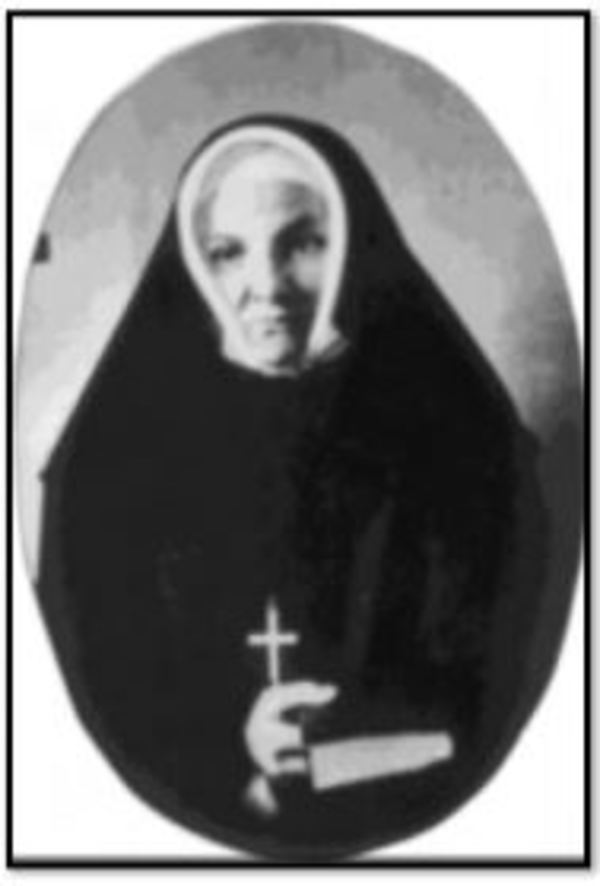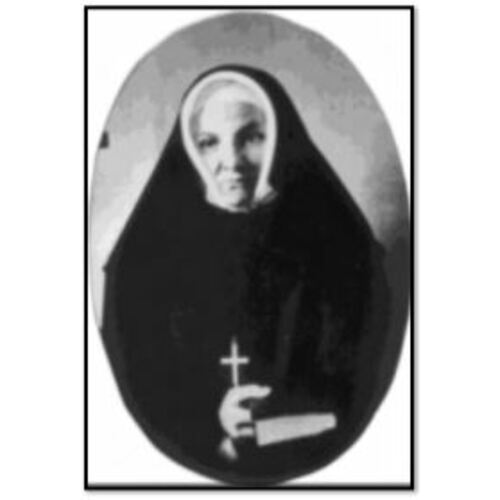
Source: Link
VALOIS, SALOMÉE, named Marie du Sacré-Cœur, Sister of St Anne, teacher, directress, hospital worker, and administrator; b. 13 April 1830 in Vaudreuil (Vaudreuil-Dorion), Lower Canada, daughter of Joseph-Eustache Valois and Angélique Lefaivre; d. 12 Nov. 1906 in Victoria.
Salomée Valois grew up as the eldest of six children of a farm family in Vaudreuil, near Montreal. Her parents sent her to the parish school, the Blondin academy. In 1848 its directress, Esther Sureau*, dit Blondin, with the sponsorship of Bishop Ignace Bourget* of Montreal, founded the order that would be known as the Sisters of St Anne and the Vaudreuil school became its convent. Three years later Salomée entered the noviciate there. She took vows of poverty, chastity, obedience, and devotion to teaching as Sister Marie du Sacré-Cœur in 1853. After the mother house transferred to Saint-Jacques-de-l’Achigan (Saint-Jacques) that year, she alternated between teaching in Vaudreuil and serving in various capacities at the mother house.
In 1857 the Sisters of St Anne accepted a call for teachers and health-care workers for the diocese of Bishop Modeste Demers* of Vancouver Island. Sister Marie du Sacré-Cœur was appointed to replace the original directress of the missionary sisters, who had fallen ill. Unlike two of her four companions she had not studied at local hospitals in preparation, but she was one of the more experienced teaching nuns.
When the sisters arrived in Victoria with the bishop on 5 June 1858, both they and he were amazed to find that the gold-rush to the mainland had made a bustling town of the fur-trade fort. In a crowded, one-room log-cabin convent, the directress organized classes for native, mixed-blood, and white settler children, home nursing, and care of the bishop’s residence and cathedral. In writing to her superior she stressed the need for English-speaking sisters with musical training to teach in a “select” convent. Fees from “select” students, particularly boarders, would help finance “free students,” care of orphans left by frontiersmen, and expansion of the sisters’ work with native peoples. Daughters of the well-to-do continued to attend the sisters’ classes in spite of the mother superior having required Governor James Douglas* to withdraw his three daughters in 1859 because he felt he must have them accompany him to a naval ball.
In November 1859 Sister Marie du Sacré-Cœur turned over direction of the Sisters of St Ann (as the order was named in the west) to the newly arrived Sister Marie de la Providence. Sister Marie du Sacré-Cœur went to Quamichan – later Duncan – with Sister Marie de la Conception to found a mission school in 1864. It was a difficult task: not many Indians came or stayed; there were few settlers to provide paying pupils; and orphans were left in the sisters’ charge before their farm could supply adequate food. By 1869 Sister Marie du Sacré-Cœur had been reassigned to the Victoria convent. She assisted with administration, supervised the manual work, and cared for boarders. These girls had great affection for the nun they knew as “my Aunt Sacred Heart,” despite her continued difficulty speaking English.
When St Joseph’s Hospital was opened by the Sisters of St Ann in 1876, Sister Marie du Sacré-Cœur began a long-term assignment there charged with its laundry and the old men’s ward. Its Chinese and Japanese patients and the destitute were not accepted by other local hospitals. She made only one visit home, in 1894–95, but she wrote to encourage nieces and nephews in vocations to religious life, always signing off as “missionary sister.”
Since her death in 1906 little recognition has been given to Sister Marie du Sacré-Cœur’s work with orphans of native descent, Indians at Quamichan, and patients and the laundry in St Joseph’s Hospital. Yet it was these humble efforts that contributed to the reputation the historian of the Sisters of St Ann in British Columbia would memorialize in A century of service. Sister Marie du Sacré-Cœur should be remembered as a French Canadian woman whose western missionary venture both attracted women to the Sisters of St Ann and shaped the character of the congregation.
ANQ-M, CE1-50, 13 avril 1830. Sisters of St Ann Arch. (Victoria), RG 1, S 17, box 8; S 24-2-2 (Sœur Marie du Sacré-Cœur, lettres à la réverende mère supérieure, 17 juill., 10 déc. 1858; 17 mars, 5 août, 9 nov. 1859) (copies). Daily Colonist (Victoria), 1861–75. Sœur Marie-Angèle [Gauthier], “Lettre de la sœur Marie-Angèle, sœur de Ste. Anne, à Vancouver,” L’Ordre (Montréal), 1er, 5, 19, 22 avril 1859. [A typescript translation, “Journal of Sister Mary Angèle, Vancouver, 1858,” is in Sisters of St Ann Arch., RG I, S 24-1-5 The same file contains “Sisters of Saint Ann on the north Pacific shores, 1858–1940, valuable notes . . . ,” comp. Sister Mary Theodore, including an entry on Sister Marie du Sacré-Cœur on p.5.] Jean Barman, “Transfer, imposition or consensus? The emergence of educational structures in nineteenth-century British Columbia,” Schools in the west: essays in Canadian educational history, ed. N. M. Sheehan et al. (Calgary, 1986), 241–64. Marie Besner, named Sœur Marie-Rollande, Sœur Marie du Sacré-Cœur, s.s.a., 1830–1906 (Lachine, Qué., 1949). Marta Danylewycz, Taking the veil: an alternative to marriage, motherhood, and spinsterhood in Quebec, 1840–1920, ed. P.-A. Linteau et al. (Toronto, 1987). Sister Mary Margaret [Edith] Down, A century of service, 1858–1958: a history of the Sisters of Saint Ann and their contribution to education in British Columbia, the Yukon and Alaska (Victoria, 1966). Micheline Dumont et Nadia Fahmy-Eid et al., Les couventines: l’éducation des filles au Québec dans les congrégations religieuses enseignantes, 1840–1960 (Montréal, 1986). Sœur Marie-Jean de Pathmos [Laura Jean], Les sœurs de Sainte-Anne; un siècle d’histoire (Lachine, 1950) [a copy of the translation by Sister Marie Anne Eva, A history of the Sisters of St. Anne (New York, 1961), is in the Sisters of St Ann Arch.]. Wayne Suttles, Coast Salish essays (Vancouver, 1967).
Cite This Article
Jacqueline Gresko, “VALOIS, SALOMÉE, named Marie du Sacré-Cœur,” in Dictionary of Canadian Biography, vol. 13, University of Toronto/Université Laval, 2003–, accessed January 19, 2026, https://www.biographi.ca/en/bio/valois_salomee_13E.html.
The citation above shows the format for footnotes and endnotes according to the Chicago manual of style (16th edition). Information to be used in other citation formats:
| Permalink: | https://www.biographi.ca/en/bio/valois_salomee_13E.html |
| Author of Article: | Jacqueline Gresko |
| Title of Article: | VALOIS, SALOMÉE, named Marie du Sacré-Cœur |
| Publication Name: | Dictionary of Canadian Biography, vol. 13 |
| Publisher: | University of Toronto/Université Laval |
| Year of publication: | 1994 |
| Year of revision: | 1994 |
| Access Date: | January 19, 2026 |



